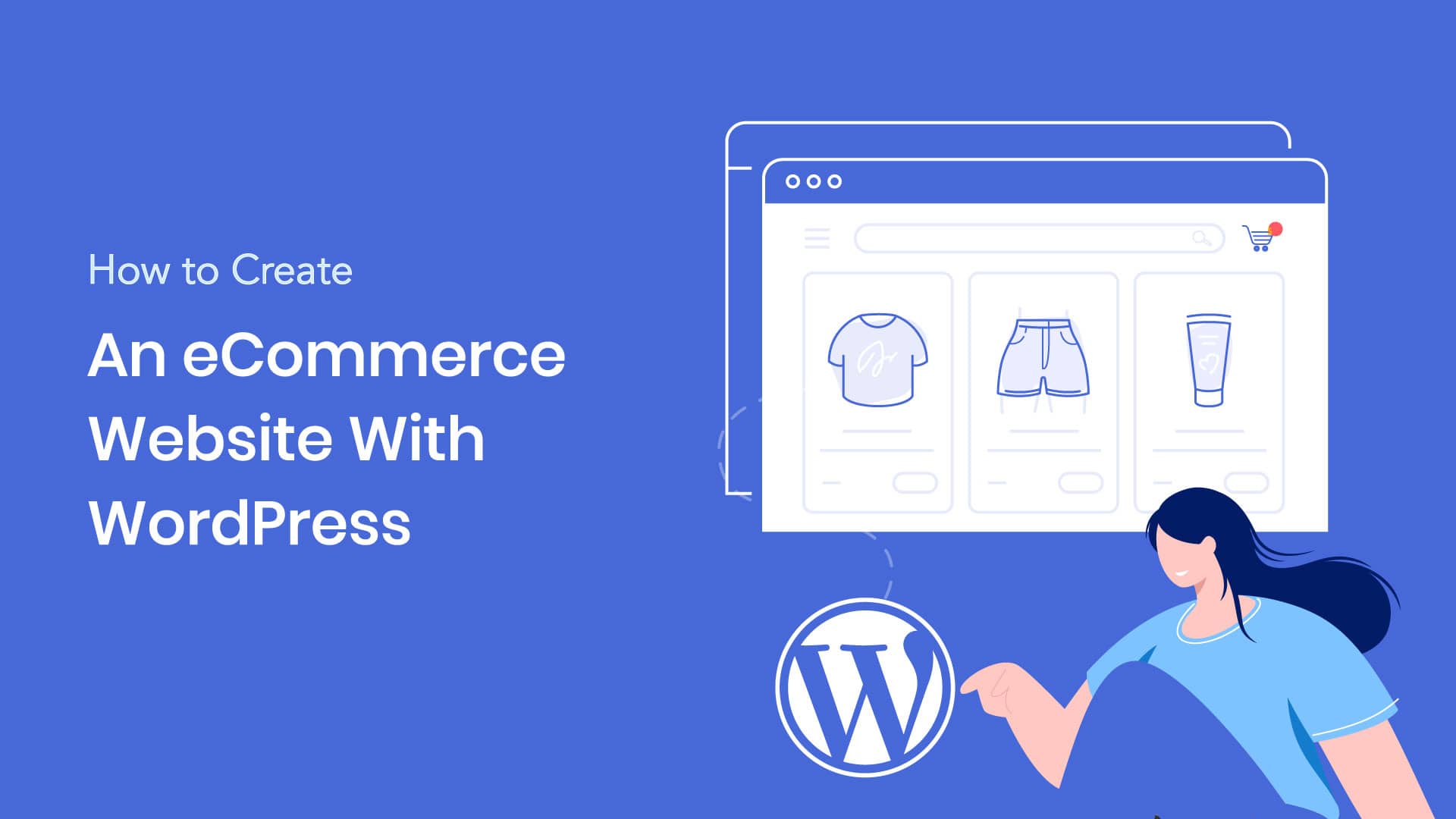
[ad_1]
Making an attempt to learn how to create an eCommerce web site with WordPress?
Whereas WordPress initially began as a running a blog software, it’s lengthy since morphed into a robust web site constructing software that’s able to creating any sort of eCommerce retailer.
In reality, WordPress is the preferred method to make an eCommerce retailer — much more in style than Shopify.
On this tutorial, we’re going to cowl the entire info that you just want to add your retailer to the ranks of the preferred eCommerce software on the Web.
And, right here’s my promise:
You’ll give you the option to totally arrange your retailer with out ever a single line of code. By the top, you’ll have a completely functioning WordPress eCommerce retailer that appears one thing like this:
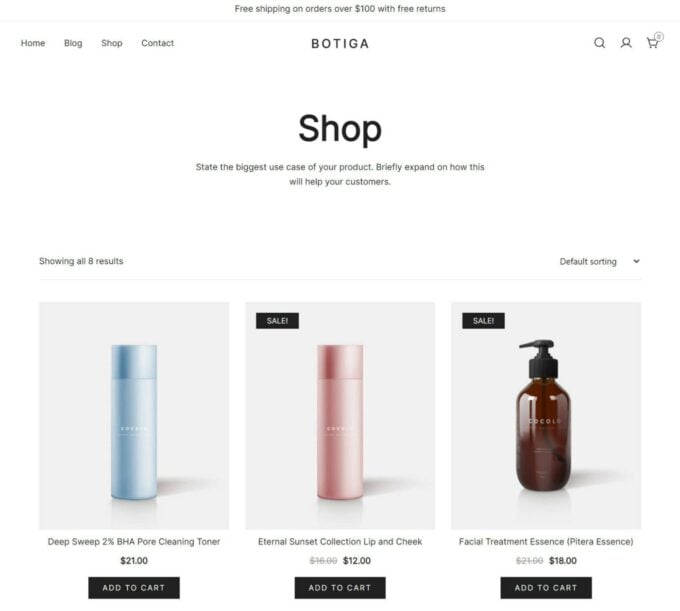
Let’s dig in!
How Does eCommerce Work on WordPress?
Under, we’re going to undergo an in depth tutorial on how to create an eCommerce web site with WordPress.
Nonetheless, earlier than digging into the gory particulars, I feel it’s helpful to take a high-level take a look at what it’s like to use WordPress for eCommerce. That method, you’ll have the total context earlier than digging into the tutorial.
So — let’s begin firstly.
Should you’ve already constructed a WordPress website earlier than, you’ve in all probability observed that the core WordPress software program doesn’t embrace any eCommerce options.
Nonetheless, as is at all times the case, you’ll be able to add full eCommerce performance utilizing a plugin. More often than not, that plugin is WooCommerce, although there are another choices that I’ll focus on in a second.
So to create the foundations of your eCommerce retailer, the place to begin appears to be like like this:
- You arrange your primary WordPress website for those who haven’t accomplished so already.
- You put in a WordPress eCommerce plugin resembling WooCommerce.
After getting that eCommerce basis, you’ll construct out your retailer similar to every other WordPress website:
- To regulate the design, you’ll set up a WordPress theme that’s suitable with WooCommerce (or your chosen eCommerce plugin) — for instance, the Botiga theme.
- You’ll dig into WooCommerce’s many settings to management key particulars resembling funds, delivery, taxes, and extra.
- You’ll set up further WordPress plugins to prolong your retailer with new options.
Don’t fear; I’m going to cowl all of that on this tutorial, so it will make extra sense in a second.
Which Is the Finest WordPress eCommerce Plugin?
When speaking about eCommerce on WordPress, the default expectation is nearly at all times that you just’re going to use the WooCommerce plugin.
WooCommerce isn’t simply the preferred WordPress eCommerce plugin by a big margin, however it’s additionally the preferred method to make an eCommerce retailer — much more in style than Shopify for those who take a look at BuiltWith’s prime a million websites index.
For that purpose, I’m going to use WooCommerce within the tutorial under.
Nonetheless, WooCommerce just isn’t the one viable WordPress eCommerce plugin, so let’s run over a couple of of the opposite high quality choices and when you may want to use them:
- Straightforward Digital Downloads (EDD) – This one is usually a good choice for those who’re particularly promoting digital information relatively than bodily merchandise. Whereas WooCommerce may also deal with digital information, EDD’s singular focus creates a extra streamlined expertise.
- BigCommerce – BigCommerce is a SaaS eCommerce software that integrates very deeply with WordPress to create a type of “headless eCommerce” strategy. That is extra superior, however it offers you loads of flexibility. The primary purpose to contemplate BigCommerce over WooCommerce is for those who’re participating in multi-platform promoting, i.e. you’re additionally promoting by way of Amazon, eBay, and different platforms. With BigCommerce, you’ll be able to sync all your totally different gross sales channels in a single spot, which provides loads of comfort.
- Ecwid – Ecwid is one other SaaS eCommerce software that integrates with WordPress thanks to a devoted plugin. It may be an excellent choice for novices with very primary shops due to its easy strategy, however I don’t actually advocate it for severe shops because it’s not almost as versatile and highly effective as WooCommerce.
With that being stated, WooCommerce continues to be the perfect eCommerce plugin for the overwhelming majority of on-line shops.
Until you might have a really particular and well-thought-out purpose for selecting a special WordPress eCommerce plugin, I extremely advocate you stick with WooCommerce.
WordPress eCommerce FAQs
Now, let’s shortly run over a couple of FAQs in order that you already know what to count on from this tutorial, in addition to WordPress eCommerce typically.
How A lot Does a WordPress eCommerce Retailer Value?
WordPress and WooCommerce are each 100% free. Nonetheless, there are a couple of related prices to your retailer.
At a primary degree, you’ll want internet hosting and a website identify for those who don’t have already got a WordPress website. Should you’ve already arrange your website, you should use your current internet hosting. However for those who haven’t but, price range at the least $10 monthly for a small retailer and extra for a retailer with excessive site visitors and/or plenty of merchandise.
Past that, you’ll nearly actually need to buy some premium instruments to add to the core WooCommerce plugin.
First, you may want a premium WooCommerce theme, which is able to price you about $60 (although there are additionally high quality free WooCommerce themes).
Second, you may additionally need some premium WooCommerce extension plugins, which is the largest price space for many shops.
Sadly, there’s method an excessive amount of variability to give a single quantity right here. Some shops would possibly solely spend $100 on plugins, whereas others would possibly spend $1,000+. Should you’re on a good price range, you’ll be able to normally discover methods to preserve your WooCommerce plugin prices down, although.
Do I Want to Be a Developer to Create a WordPress eCommerce Retailer?
No, you don’t want any particular technical data to comply with this tutorial and arrange your eCommerce retailer. You are able to do just about all the things from the person interface; there’s no want to ever take a look at a line of code.
There are extra settings than in your common WordPress website since you’ll want to configure particulars resembling delivery, taxes, and cost gateways. However, all this takes is a few further time — it doesn’t require any particular technical data.
How Lengthy Does It Take to Create a WordPress eCommerce Retailer?
The essential course of of making your retailer’s basis takes little or no time. You may have a pretty functioning eCommerce retailer in properly below an hour (even much less if you have already got an current WordPress website).
Nonetheless, that doesn’t imply you’ll be completed in below an hour. You’ll spend most of your time configuring the nitty-gritty particulars of your retailer, resembling:
- Delivery charges and insurance policies
- Tax charges
- Including merchandise
- Cost gateways
- And so forth.
None of those duties are complicated, however it’s going to take you a while to work by way of the small print, particularly if you’d like to do issues manually relatively than utilizing a plugin to assist out (which could price cash in some circumstances).
The great factor, although, is that the majority of those duties are one-time issues. For instance, when you arrange your delivery charges, your retailer will mechanically use them with out requiring additional enter from you.
Is a WordPress eCommerce Retailer Safe?
Sure, so long as you’re utilizing safe internet hosting and following WordPress safety finest practices, your retailer is completely safe.
Moreover, your retailer’s bank card funds will likely be processed by a third-party gateway resembling PayPal or Stripe, so that you received’t want to deal with the stress of safe cost processing and PCI compliance. The third-party processor is totally answerable for all of that.
Can a WordPress eCommerce Retailer Load Quick?
Sure, completely. Once more, the important thing element right here is that your retailer will load quick so long as you’re following WordPress efficiency finest practices, resembling utilizing a quick WooCommerce theme and optimizing your content material.
Later on this tutorial, we’ll have an entire part devoted to exhibiting you the way to make your retailer load quick. As with the remainder of the tutorial, this received’t require any particular data.
How to Create an eCommerce Website with WordPress
Now that you’ve a good suggestion of how WordPress eCommerce works, let’s dig into the total step-by-step tutorial.
This information will take you from “zero” to a completely functioning eCommerce retailer powered by WordPress.
1. Set Up Your WordPress Web site (If You Don’t Have One Already)
If you have already got a primary WordPress website, you’ll be able to click on right here to skip forward to the subsequent part to find out how to add eCommerce performance to that website.
Nonetheless, for those who don’t have a WordPress website but, you’ll want to arrange one earlier than you’ll be able to flip it into a completely functioning eCommerce retailer.
To do this, you’ll want to do three issues:
- Select the area identify to your eCommerce retailer. This will likely be its everlasting deal with on the Web. For instance, ours is athemes.com.
- Buy internet hosting. That is what powers the WordPress software program and makes your eCommerce retailer obtainable to guests from across the globe.
- Set up the WordPress software program. This may get your primary website up and operating. When you arrange the core WordPress software program, you’ll be able to proceed with turning it into an eCommerce retailer.
Select and Buy a Area Identify
To buy your area identify, you should use a service resembling Google Domains or Cloudflare Registrar.
Should you’re struggling to come up with an excellent area identify that’s nonetheless obtainable, you should use a website generator resembling LeanDomainSearch.
Buy Internet hosting
For WordPress/WooCommerce internet hosting, I like to recommend Cloudways as an excellent inexpensive choice that also affords glorious efficiency. Try my Cloudways evaluate to study extra about it.
SiteGround can be a stable choice for novices, because it’s a bit less complicated to use (although Cloudways continues to be fairly accessible).
Set up WordPress
After getting your internet hosting, you should use your internet host’s WordPress auto-installer software to set up the fundamental WordPress software program.
Should you’re utilizing Cloudways, you’ll be able to comply with this documentation to set up WordPress.
You’ll additionally want to set up a free SSL certificates to allow the safe HTTPS protocol in your web site. Cloudways and most different high quality hosts make this very straightforward to do. It normally simply requires clicking a single button — right here’s how to do it at Cloudways.
2. Set up WooCommerce and Configure the Fundamentals
At this level, you must have your primary WordPress website arrange. Now, it’s time to flip it right into a functioning eCommerce retailer by putting in the WooCommerce plugin.
WooCommerce is obtainable at no cost at WordPress.org, so you’ll be able to set up it like every other WordPress plugin:
- Go to Plugins → Add New in your WordPress dashboard.
- Seek for “WooCommerce”.
- Set up and activate the plugin.
When you activate WooCommerce, it ought to mechanically launch its guided setup wizard. If it doesn’t or for those who by accident closed it, you’ll be able to manually open the guided wizard by following these directions.
Now, let’s undergo the setup steps.
Retailer Particulars
On step one, you’ll enter some primary particulars about your retailer’s location:

Business Particulars
Subsequent, you’ll be requested to enter some particulars about your retailer’s trade:

Product Varieties
Then, select the kinds of merchandise that you really want to promote.
Most shops will simply need to verify the Bodily merchandise field. Should you’re promoting digital merchandise, you’ll be able to choose Downloads:

Enterprise Particulars
Lastly, you’ll enter some further enterprise particulars about your retailer:
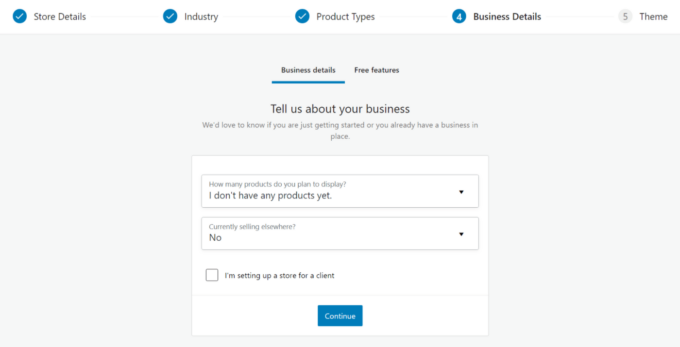
WooCommerce may also immediate you to add “free enterprise options” to your retailer. You may click on the accordion to broaden the choices.
For most individuals, I like to recommend putting in the entire “fundamentals” as these will provide help to with funds, delivery, and such. The “develop your retailer” part is completely elective, although.
The “fundamentals” embrace WooCommerce’s devoted providers for funds, delivery, and taxes, that are the only method to arrange these key areas of your retailer (although you should use different instruments/plugins).
Should you don’t need to determine now, you’ll be able to uncheck all of them — you’ll be able to at all times set up them afterward:

Theme
Lastly, the setup wizard will immediate you to set up a theme.
Simply skip this part by clicking Proceed with my lively theme — I’m going to cowl establishing your WooCommerce theme within the subsequent part:
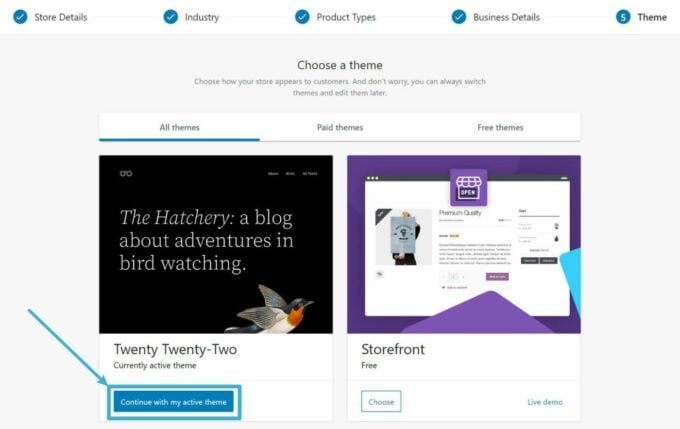
Should you’ve put in the “free enterprise options”, you’ll be prompted to join your WooCommerce retailer to your WordPress.com account. Should you don’t have a WordPress.com account but, you’ll additionally want to create one.
This account is free, however it’s required to use the devoted providers for funds, delivery, and taxes:

3. Select a WooCommerce Theme
At this level, you might have a functioning retailer…however it in all probability doesn’t appear like an eCommerce retailer.
To repair that, you’ll want to set up a purpose-built WooCommerce theme.
There are some things to search for in a high quality WooCommerce theme, together with:
- Design – Clearly, you need your theme to have a fantastic design that matches your required aesthetic.
- Options – When you’ll add most eCommerce options utilizing plugins relatively than your theme, you’ll nonetheless need to search for primary performance, resembling whether or not the theme offers a user-friendly product search choice or how its product filters look.
- Efficiency – Your theme performs a big position in your retailer’s efficiency and cargo instances, so it’s important to select a light-weight WooCommerce theme that received’t decelerate your retailer.
We created our Botiga theme to do an excellent job in all of these areas:
- It appears to be like nice, with a contemporary, minimal design. You may also select from totally different importable demo websites to get the right search for your retailer.
- It has all of the options an on-line retailer wants from a theme, resembling shopper-friendly product search, helpful product filters, gross sales badges, and much extra.
- It’s constructed to load quick. It weighs simply 44.Three KB, minifies its personal code, and achieves excellent efficiency scores out of the field.

For these causes, I’m going to use Botiga for this tutorial. We’ll stick with the free model of the theme, however there’s additionally a premium model that provides extra options if you’d like them.
Set up the Botiga Theme
To get began with Botiga, go to Look → Themes → Add New in your WordPress dashboard.
Then, seek for and set up the free Botiga theme from WordPress.org.
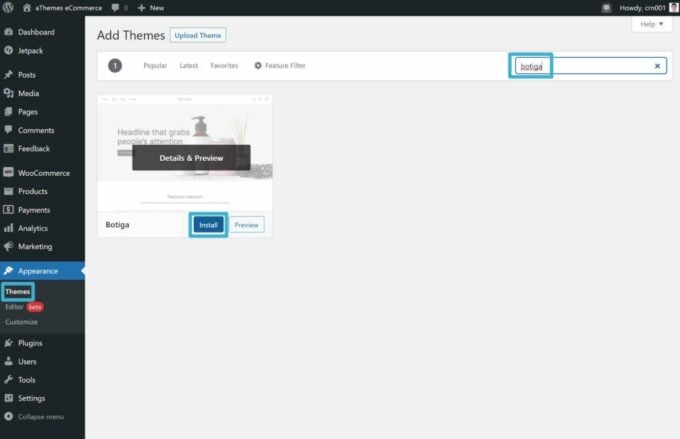
Import a Demo Web site
When you activate the Botiga theme, you’ll see a immediate to import considered one of Botiga’s demo websites. That is elective, however it’s going to have you ever up and operating with a trendy retailer from day one.
In order for you to import a demo website, click on the Starter Websites button:
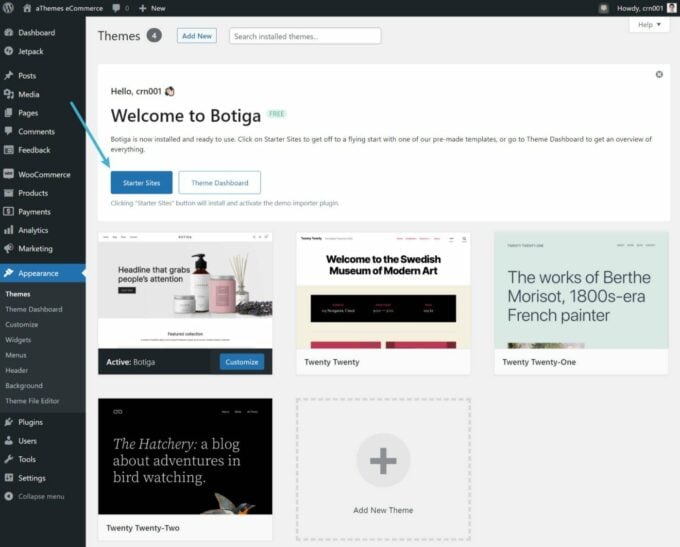
It should mechanically take you to the starter websites space. Or, you’ll be able to go to Look → Starter Websites.
To import a website, simply hover over it and click on the Import button:

This may launch a popup the place you’ll be able to select precisely which content material to import. Finalize your decisions after which click on Import once more:
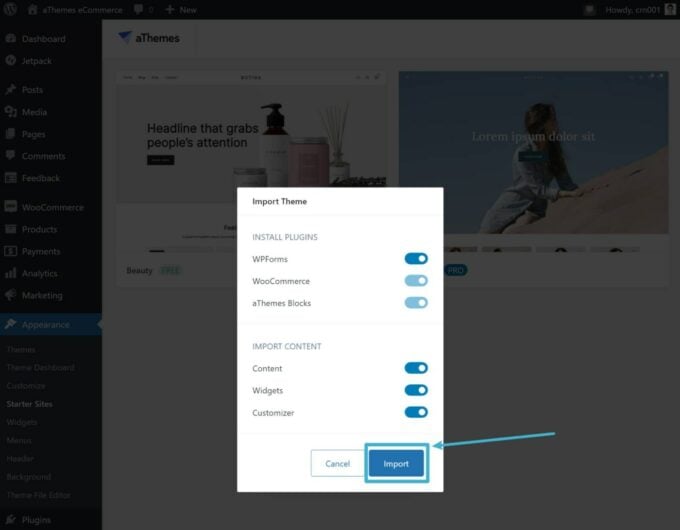
Should you imported the entire demo content material, your retailer ought to now look precisely just like the demo website that you just selected.
Customise the Demo Content material
Now, you can also make the content material your individual.
To customise the theme kinds, resembling fonts and colours, you’ll be able to go to Look → Customise.
And, to customise the person pages, you’ll be able to go to the Pages space and edit them similar to every other WordPress web page. All of Botiga’s demo content material makes use of the native WordPress editor, which helps your retailer load as quick as potential.
4. Add Your Merchandise
Now that your retailer really appears to be like like an eCommerce retailer, you’re prepared to begin including merchandise.
There are a couple of different particulars you’ll need to configure, however it’s at all times motivating to see your first dwell product, which is why I’m placing this part first.
Be aware — for those who imported a full Botiga demo website, Botiga will import some instance merchandise as a part of the method. You should use these instance merchandise as inspiration and delete them whenever you’ve added your individual merchandise.
To create a product, go to Merchandise → Add New.
Right here, fill out the product info. Pay particular consideration to the next areas:
- Title
- Quick and lengthy description
- Value
- Product picture
- Product classes
- Product tags
- Product sort (obtainable within the dropdown on the prime of the Product knowledge field) — for instance, whether or not it’s a easy or a variable product (e.g. a t-shirt with a number of sizes)
You may also use the tabs within the Product knowledge field to configure different particulars resembling stock, dimensions/weight, linked merchandise, and extra.
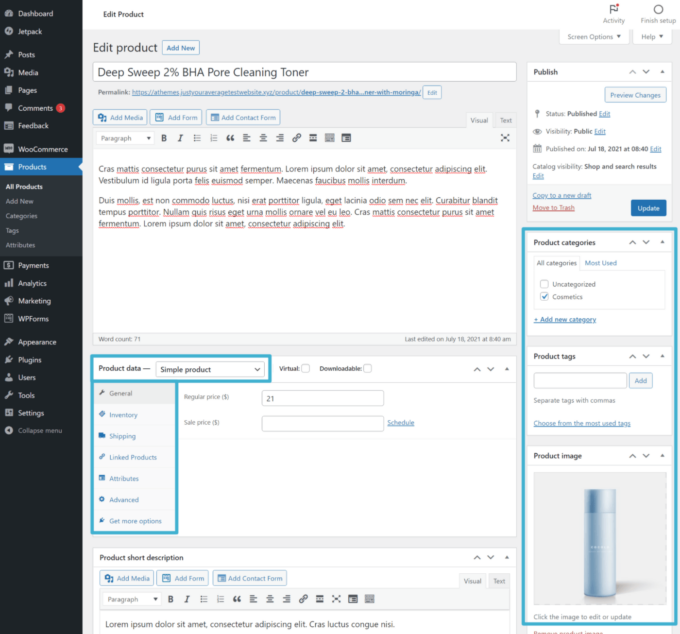
Don’t fear about messing something up — you’ll be able to at all times come again and edit these particulars afterward.
If you’re completely satisfied with how all the things appears to be like, click on the Replace or Publish button similar to you’d for a weblog submit. As quickly as you do this, your product will likely be dwell on the frontend of your retailer.
So as to add extra merchandise, all you want to do is repeat the method.
If in case you have tons of or hundreds of merchandise, it’s also possible to import your merchandise by way of a CSV file, which may save a while.
5. Configure Different WooCommerce Settings
Now, it’s time for probably the most boring a part of this tutorial: establishing nitty-gritty particulars resembling funds, taxes, delivery, and so on.
Whereas this is usually a little tedious and time-consuming, it’s important to the functioning of your retailer, so you’ll be able to’t simply skip it.
How you’ll do that actually is dependent upon your retailer’s location and configuration, so I can’t present one particular tutorial for each variation. Nonetheless, I’ll cowl the highlights so that you just usually know what you want to do.
start line is to go to WooCommerce → Dwelling in your dashboard, the place you must see a guidelines:
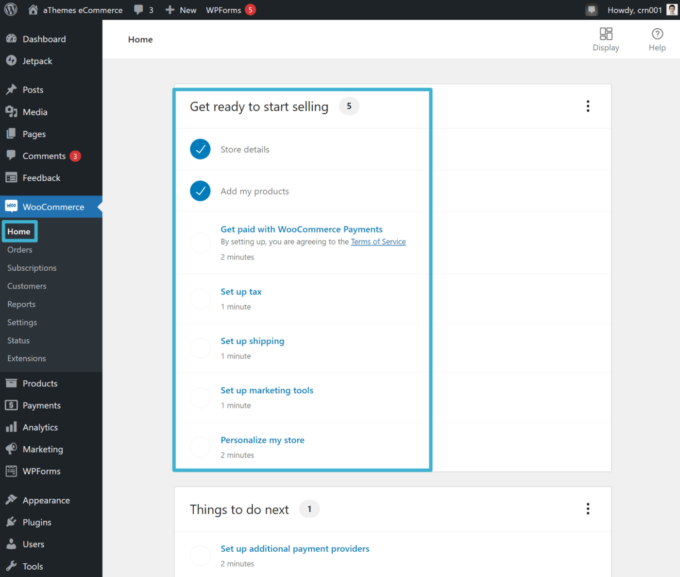
Let’s undergo the important thing settings.
Funds
The best method to arrange funds is to use the official WooCommerce Funds service (which is predicated on Stripe). Should you put in that as a part of the setup course of, all you want to do is click on the Receives a commission with WooCommerce Funds choice within the guidelines above to launch the setup wizard.
In order for you to configure a special gateway or use Stripe immediately, you’ll be able to go to WooCommerce → Settings → Funds:
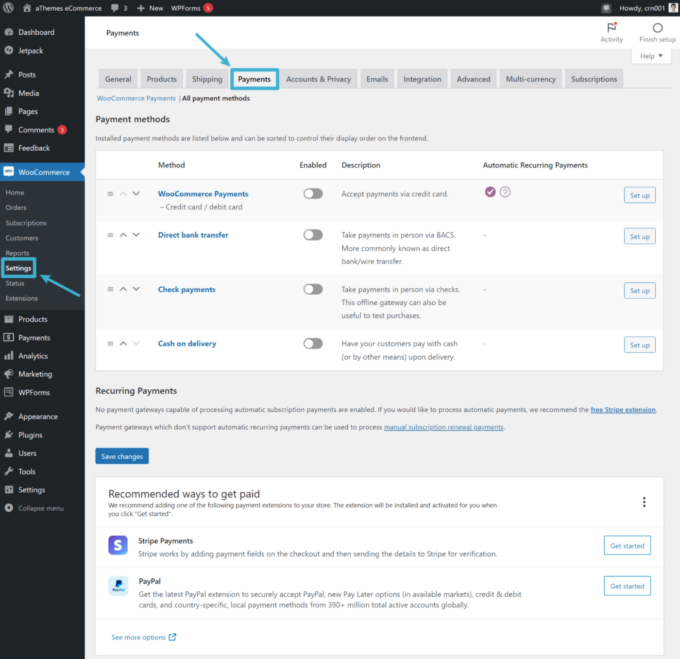
You may also set up different third-party cost gateway plugins if wanted, which will be useful if there’s a sure native cost gateway that you really want to use.
Delivery Charges
There are two important ways in which most shops strategy delivery on WooCommerce:
- Desk-rate delivery – You may enter a set of delivery guidelines. For instance, packages below 1 pound price $5, packages between 1-5 kilos price $10, and packages above 5 kilos price $15.
- Actual-time charges – You may calculate real-time delivery charges based mostly on the precise dimensions of every order. You may combine with USPS, UPS, FedEx, and others.
WooCommerce does have its personal built-in options for delivery guidelines. Nonetheless, you’ll in all probability desire a separate delivery plugin as a result of the built-in options don’t help table-rate and real-time charges.
In order for you to discover the built-in delivery settings, you’ll be able to go to WooCommerce → Settings → Delivery.
First, you’ll outline delivery zones, that are groupings of a number of geographic areas. For instance, you may need one zone for the continental USA:
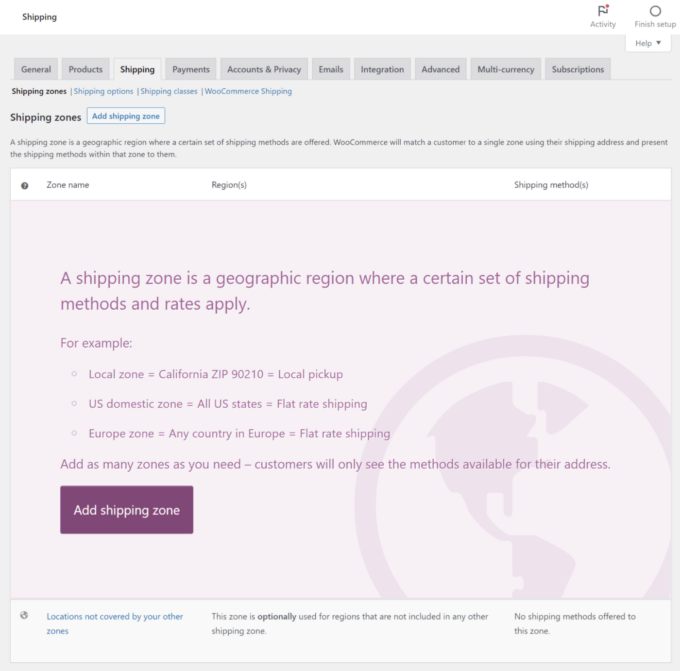
When you’ve created a zone, you’ll be able to add delivery strategies for that zone, which is able to solely be seen to clients in one of many chosen geographic areas.
There are three choices:
- Flat price
- Free delivery
- Native pickup

When you add a way, you’ll be able to enter its price.
Nonetheless, the built-in delivery characteristic doesn’t allow you to change the associated fee based mostly on the burden/dimensions of a package deal, which is why you’ll in all probability need both a table-rate delivery plugin or a real-time charges plugin.
You may also contemplate a full order achievement service resembling ShipStation or TrackShip.
Taxes
The final main settings space to contemplate is your retailer’s taxes. In lots of authorized jurisdictions, you’ll want to acquire some sort of gross sales tax or VAT out of your clients.
For simplicity, you’ll in all probability need to use a plugin right here. The favored choices are WooCommerce Tax and Avalara:
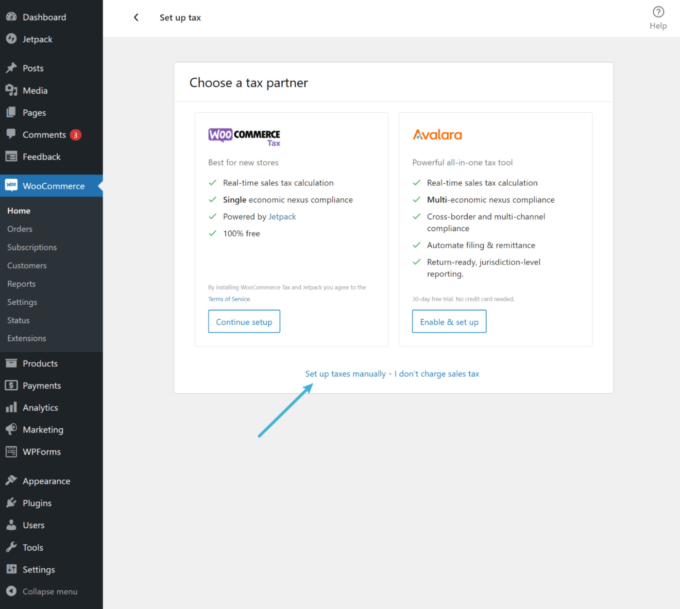
WooCommerce additionally has a handbook tax choice, although it tries to cover it as a result of it’s complicated. To allow handbook taxes, you want to click on the Arrange tax choice after which choose the handbook choice.
When you do this, you’ll get a brand new settings space at WooCommerce → Settings → Taxes:

The quickest method to add handbook taxes can be to import a CSV of tax guidelines. For instance, you should buy a frequently up to date CSV of USA tax guidelines for $29 from this website.
Different Settings
Whereas funds, delivery, and taxes are a number of the most vital settings for WooCommerce shops, they’re far from the one issues that you may management. So I extremely advocate exploring the opposite choices within the WooCommerce settings space.
For lots of the settings, you’ll be completely fantastic to depart them because the defaults.
Nonetheless, you would possibly uncover some settings that you just suppose can be higher to modify.
For instance, for those who go to WooCommerce → Settings → Emails, you’ll be able to customise the content material of the emails that your retailer sends to clients and admins, resembling the e-mail {that a} shopper receives after they place an order:

6. Set up Plugins to Add Extra Options
Probably the greatest issues about utilizing WooCommerce for WordPress eCommerce is the large library of official and third-party plugins that you should use to prolong WooCommerce.
Your retailer will completely depend on plugins to add key options. I don’t suppose there’s a single retailer that doesn’t have at the least some WooCommerce plugins.
Be aware that WooCommerce plugins are simply common WordPress plugins. I’m solely calling them “WooCommerce plugins” for simplicity’s sake, however you’ll set up them like every other WordPress plugin.
I already touched on plugins within the earlier part. You’ll usually need to use plugins to arrange your retailer’s cost gateways, delivery guidelines, and tax charges.
Nonetheless, it’s also possible to discover hundreds of different plugins to assist with all areas of your retailer, together with the next:
- Advertising your retailer extra successfully
- Including useful options for buyers, resembling wishlists or in-dashboard order monitoring
- Enhancing your retailer’s admin processes to handle all the things extra successfully
- Getting extra management over your retailer’s designs
- And so forth.
I can’t advocate a single set of plugins for all shops as a result of there are such a lot of variables. The important thing element right here is that you just shouldn’t be scared to use plugins to prolong WooCommerce as a result of all WooCommerce shops depend on plugins — sometimes dozens of them.
So — how are you going to discover the perfect plugins to your WooCommerce retailer?
Nicely, first off, we’re engaged on a submit that collects all the perfect WooCommerce plugins for various use circumstances. We’ll add the hyperlink to it as quickly because it’s completed.
Past that, you’ll be able to attempt looking these in style plugin marketplaces:
- WordPress.org has hundreds of free plugins tagged with WooCommerce.
- The official WooCommerce Extensions Retailer lists each free and premium plugins and contains official extensions in addition to these from third-party builders.
- CodeCanyon has over 1,400 premium plugins within the WooCommerce class.
I like to recommend beginning the method by trying to find the particular performance that you just want. Then, learn the critiques and verify the developer’s popularity, simply as for those who had been putting in every other WordPress plugin.
As a result of these plugins can have an effect on the safety and functioning of your retailer, I like to recommend solely putting in plugins from respected builders.
7. Optimize Your Retailer for Efficiency
At this level, you must have a completely functioning eCommerce retailer that’s prepared to begin receiving clients.
Nonetheless, if you’d like your retailer to be a hit, it’s important that you just optimize it to load shortly.
How shortly your retailer hundreds will have an effect on a spread of various areas, together with the next:
- Conversion charges
- Search engine rankings
- Consumer expertise
- Bounce charges
Don’t fear — for those who’ve adopted this information, you’re already midway to having a quick-loading retailer since you’re utilizing a quick theme (Botiga) and performance-optimized internet hosting (Cloudways or your most popular host).
For the only method to cowl the remainder of the vital optimization methods, you should use the WP Rocket plugin.
Whereas WP Rocket is a premium plugin, I feel it’s definitely worth the funding (my evaluate) as a result of it affords the only method to pace up your retailer.
Create Your WordPress eCommerce Retailer At the moment!
Congratulations! You simply realized how to create an eCommerce web site with WordPress, and I hope you had been in a position to do it as painlessly as potential.
Should you adopted all of the steps on this information, you must now have a completely functioning retailer that’s prepared to begin accepting orders from clients. When you begin receiving orders, these particulars will present up within the WooCommerce space of your WordPress dashboard, and also you’ll additionally obtain e mail notifications.
Or, for those who’re nonetheless within the planning levels of creating a WordPress eCommerce retailer, you at the least know what to count on whenever you begin constructing. You may come again to this information when you’re prepared to really launch your retailer.
Do you continue to have any questions on how to make a WordPress eCommerce web site? Tell us within the feedback!
[ad_2]